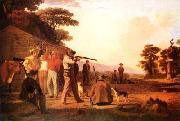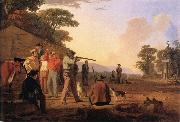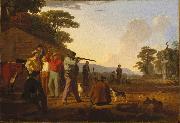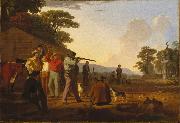
|
George Caleb Bingham
|
|||
|
|
|||
| 1811-1879 George Caleb Bingham Gallery George Caleb Bingham (March 20, 1811 ?C July 7, 1879) was an American artist, whose work depicted his view of American life in the frontier lands along the Missouri River. Left to languish in obscurity, Bingham's work was rediscovered in the 1930s and he is now widely considered one of the greatest American painters of the 1800s. Born in Augusta County, Virginia, Bingham was the second of seven children born to Henry Vest Bingham and Mary Amend. Upon their marriage, Matthias Amend, Mary's father, gave ownership to the family mill, 1,180 acres of land and several slaves to Henry with the agreement that Matthias could live with the family the rest of his life. Henry offered the land and mill as surety for a friend's debt and, when the friend died in 1818, all was lost. George's family soon moved to Franklin, Missouri "where the land was said to be bountiful, fertile and cheap." Bingham was a self-taught artist. His sole childhood exposure to the field was as a nine-year-old boy, when famed American portraitist Chester Harding visited Franklin looking for business, having recently sketched Daniel Boone in Warren County, Missouri. George assisted Harding during his brief stay, an experience that left a powerful impression. In 1823, Bingham's father, now judge of Howard County Court, died of malaria on December 26 at the age of thirty-eight. To keep the family going, Mary Bingham opened a school for girls and George, then twelve, worked as school janitor to help keep the family afloat. At age sixteen, Bingham apprenticed with cabinet maker Jesse Green. After Green moved, he apprenticed with another cabinet maker, Justinian Williams. Both tradesmen were Methodist ministers and, while under their tutelage, Bingham studied religious texts, preached at camp meetings and thought about becoming a minister himself. Bingham also considered becoming a lawyer. However, by age nineteen, Bigham was painting portraits for $20.00 apiece, often completing the works in a single day. He drummed up work in both Franklin and Arrow Rock and, while his painting abilities were still developing, succeeded in impressing his patrons with his strong draftsmanship and ability to capture the likeness of his subject. Soon Bingham attempted to travel to St. Louis to ply his trade but contracted measles, which left him weak and permanently bald. In 1836, Bingham married Sarah Elizabeth Hutchison, who bore him three children over the subsequent twelve years before dying at the age of twenty-nine. George married twice more, first to Eliza Thomas, who died in a mental institution in 1876, and then to Martha Lykins, who lived until 1890. George's mother, Mary, died in 1851. By 1838, Bingham was already beginning to make a name for himself as a portrait artist in St. Louis, his studio visited by several prominent local citizens and statesmen, including the lawyer James S. Rollins who was to become a life-long friend. To further his education, George spent three months in Philadelphia, Pennsylvania before continuing on to New York City to visit the National Academy of Design exhibition. Bingham was elected to the Missouri General Assembly in 1848. From 1856 to 1859, Bingham studied art with the members of the D??sseldorf School in D??sseldorf, Germany. Critics claim that this caused him to abandon the rustic American style in his art. Upon his return, he began painting less, turning to politics in the post-Civil War years and serving as state treasurer and adjutant general. He was also president of the Board of Police Commissioners for Kansas City, Missouri in 1874, appointing the first chief of police there . Toward the end of his life he was a professor of art at the University of Missouri in Columbia, Missouri. | |||
|
|
|||
|
Shooting for the Beef George Caleb Bingham5.jpg Painting ID:: 3095 |
|||
|
|
|||
|
George Caleb Bingham
|
|||
|
|
|||
| 1811-1879 George Caleb Bingham Gallery George Caleb Bingham (March 20, 1811 ?C July 7, 1879) was an American artist, whose work depicted his view of American life in the frontier lands along the Missouri River. Left to languish in obscurity, Bingham's work was rediscovered in the 1930s and he is now widely considered one of the greatest American painters of the 1800s. Born in Augusta County, Virginia, Bingham was the second of seven children born to Henry Vest Bingham and Mary Amend. Upon their marriage, Matthias Amend, Mary's father, gave ownership to the family mill, 1,180 acres of land and several slaves to Henry with the agreement that Matthias could live with the family the rest of his life. Henry offered the land and mill as surety for a friend's debt and, when the friend died in 1818, all was lost. George's family soon moved to Franklin, Missouri "where the land was said to be bountiful, fertile and cheap." Bingham was a self-taught artist. His sole childhood exposure to the field was as a nine-year-old boy, when famed American portraitist Chester Harding visited Franklin looking for business, having recently sketched Daniel Boone in Warren County, Missouri. George assisted Harding during his brief stay, an experience that left a powerful impression. In 1823, Bingham's father, now judge of Howard County Court, died of malaria on December 26 at the age of thirty-eight. To keep the family going, Mary Bingham opened a school for girls and George, then twelve, worked as school janitor to help keep the family afloat. At age sixteen, Bingham apprenticed with cabinet maker Jesse Green. After Green moved, he apprenticed with another cabinet maker, Justinian Williams. Both tradesmen were Methodist ministers and, while under their tutelage, Bingham studied religious texts, preached at camp meetings and thought about becoming a minister himself. Bingham also considered becoming a lawyer. However, by age nineteen, Bigham was painting portraits for $20.00 apiece, often completing the works in a single day. He drummed up work in both Franklin and Arrow Rock and, while his painting abilities were still developing, succeeded in impressing his patrons with his strong draftsmanship and ability to capture the likeness of his subject. Soon Bingham attempted to travel to St. Louis to ply his trade but contracted measles, which left him weak and permanently bald. In 1836, Bingham married Sarah Elizabeth Hutchison, who bore him three children over the subsequent twelve years before dying at the age of twenty-nine. George married twice more, first to Eliza Thomas, who died in a mental institution in 1876, and then to Martha Lykins, who lived until 1890. George's mother, Mary, died in 1851. By 1838, Bingham was already beginning to make a name for himself as a portrait artist in St. Louis, his studio visited by several prominent local citizens and statesmen, including the lawyer James S. Rollins who was to become a life-long friend. To further his education, George spent three months in Philadelphia, Pennsylvania before continuing on to New York City to visit the National Academy of Design exhibition. Bingham was elected to the Missouri General Assembly in 1848. From 1856 to 1859, Bingham studied art with the members of the D??sseldorf School in D??sseldorf, Germany. Critics claim that this caused him to abandon the rustic American style in his art. Upon his return, he began painting less, turning to politics in the post-Civil War years and serving as state treasurer and adjutant general. He was also president of the Board of Police Commissioners for Kansas City, Missouri in 1874, appointing the first chief of police there . Toward the end of his life he was a professor of art at the University of Missouri in Columbia, Missouri. | |||
|
|
|||
|
Shooting For the Beef new12/George Caleb Bingham-459299.jpg Painting ID:: 39065 |
mk140 1850 Oil on canvas 84.8x124.5cm | ||
|
|
|||
|
George Caleb Bingham
|
|||
|
|
|||
| 1811-1879 George Caleb Bingham Gallery George Caleb Bingham (March 20, 1811 ?C July 7, 1879) was an American artist, whose work depicted his view of American life in the frontier lands along the Missouri River. Left to languish in obscurity, Bingham's work was rediscovered in the 1930s and he is now widely considered one of the greatest American painters of the 1800s. Born in Augusta County, Virginia, Bingham was the second of seven children born to Henry Vest Bingham and Mary Amend. Upon their marriage, Matthias Amend, Mary's father, gave ownership to the family mill, 1,180 acres of land and several slaves to Henry with the agreement that Matthias could live with the family the rest of his life. Henry offered the land and mill as surety for a friend's debt and, when the friend died in 1818, all was lost. George's family soon moved to Franklin, Missouri "where the land was said to be bountiful, fertile and cheap." Bingham was a self-taught artist. His sole childhood exposure to the field was as a nine-year-old boy, when famed American portraitist Chester Harding visited Franklin looking for business, having recently sketched Daniel Boone in Warren County, Missouri. George assisted Harding during his brief stay, an experience that left a powerful impression. In 1823, Bingham's father, now judge of Howard County Court, died of malaria on December 26 at the age of thirty-eight. To keep the family going, Mary Bingham opened a school for girls and George, then twelve, worked as school janitor to help keep the family afloat. At age sixteen, Bingham apprenticed with cabinet maker Jesse Green. After Green moved, he apprenticed with another cabinet maker, Justinian Williams. Both tradesmen were Methodist ministers and, while under their tutelage, Bingham studied religious texts, preached at camp meetings and thought about becoming a minister himself. Bingham also considered becoming a lawyer. However, by age nineteen, Bigham was painting portraits for $20.00 apiece, often completing the works in a single day. He drummed up work in both Franklin and Arrow Rock and, while his painting abilities were still developing, succeeded in impressing his patrons with his strong draftsmanship and ability to capture the likeness of his subject. Soon Bingham attempted to travel to St. Louis to ply his trade but contracted measles, which left him weak and permanently bald. In 1836, Bingham married Sarah Elizabeth Hutchison, who bore him three children over the subsequent twelve years before dying at the age of twenty-nine. George married twice more, first to Eliza Thomas, who died in a mental institution in 1876, and then to Martha Lykins, who lived until 1890. George's mother, Mary, died in 1851. By 1838, Bingham was already beginning to make a name for himself as a portrait artist in St. Louis, his studio visited by several prominent local citizens and statesmen, including the lawyer James S. Rollins who was to become a life-long friend. To further his education, George spent three months in Philadelphia, Pennsylvania before continuing on to New York City to visit the National Academy of Design exhibition. Bingham was elected to the Missouri General Assembly in 1848. From 1856 to 1859, Bingham studied art with the members of the D??sseldorf School in D??sseldorf, Germany. Critics claim that this caused him to abandon the rustic American style in his art. Upon his return, he began painting less, turning to politics in the post-Civil War years and serving as state treasurer and adjutant general. He was also president of the Board of Police Commissioners for Kansas City, Missouri in 1874, appointing the first chief of police there . Toward the end of his life he was a professor of art at the University of Missouri in Columbia, Missouri. | |||
|
|
|||
|
Shooting for the Beef new23/George Caleb Bingham-854445.jpg Painting ID:: 71411 |
ca. 1850(1850) Oil on canvas 84.8 x 124.5 cm (33.39 x 49.02 in) | ||
|
|
|||
|
George Caleb Bingham
|
|||
|
|
|||
| 1811-1879 George Caleb Bingham Gallery George Caleb Bingham (March 20, 1811 ?C July 7, 1879) was an American artist, whose work depicted his view of American life in the frontier lands along the Missouri River. Left to languish in obscurity, Bingham's work was rediscovered in the 1930s and he is now widely considered one of the greatest American painters of the 1800s. Born in Augusta County, Virginia, Bingham was the second of seven children born to Henry Vest Bingham and Mary Amend. Upon their marriage, Matthias Amend, Mary's father, gave ownership to the family mill, 1,180 acres of land and several slaves to Henry with the agreement that Matthias could live with the family the rest of his life. Henry offered the land and mill as surety for a friend's debt and, when the friend died in 1818, all was lost. George's family soon moved to Franklin, Missouri "where the land was said to be bountiful, fertile and cheap." Bingham was a self-taught artist. His sole childhood exposure to the field was as a nine-year-old boy, when famed American portraitist Chester Harding visited Franklin looking for business, having recently sketched Daniel Boone in Warren County, Missouri. George assisted Harding during his brief stay, an experience that left a powerful impression. In 1823, Bingham's father, now judge of Howard County Court, died of malaria on December 26 at the age of thirty-eight. To keep the family going, Mary Bingham opened a school for girls and George, then twelve, worked as school janitor to help keep the family afloat. At age sixteen, Bingham apprenticed with cabinet maker Jesse Green. After Green moved, he apprenticed with another cabinet maker, Justinian Williams. Both tradesmen were Methodist ministers and, while under their tutelage, Bingham studied religious texts, preached at camp meetings and thought about becoming a minister himself. Bingham also considered becoming a lawyer. However, by age nineteen, Bigham was painting portraits for $20.00 apiece, often completing the works in a single day. He drummed up work in both Franklin and Arrow Rock and, while his painting abilities were still developing, succeeded in impressing his patrons with his strong draftsmanship and ability to capture the likeness of his subject. Soon Bingham attempted to travel to St. Louis to ply his trade but contracted measles, which left him weak and permanently bald. In 1836, Bingham married Sarah Elizabeth Hutchison, who bore him three children over the subsequent twelve years before dying at the age of twenty-nine. George married twice more, first to Eliza Thomas, who died in a mental institution in 1876, and then to Martha Lykins, who lived until 1890. George's mother, Mary, died in 1851. By 1838, Bingham was already beginning to make a name for himself as a portrait artist in St. Louis, his studio visited by several prominent local citizens and statesmen, including the lawyer James S. Rollins who was to become a life-long friend. To further his education, George spent three months in Philadelphia, Pennsylvania before continuing on to New York City to visit the National Academy of Design exhibition. Bingham was elected to the Missouri General Assembly in 1848. From 1856 to 1859, Bingham studied art with the members of the D??sseldorf School in D??sseldorf, Germany. Critics claim that this caused him to abandon the rustic American style in his art. Upon his return, he began painting less, turning to politics in the post-Civil War years and serving as state treasurer and adjutant general. He was also president of the Board of Police Commissioners for Kansas City, Missouri in 1874, appointing the first chief of police there . Toward the end of his life he was a professor of art at the University of Missouri in Columbia, Missouri. | |||
|
|
|||
|
Shooting for the Beef new24/George Caleb Bingham-863444.jpg Painting ID:: 72561 |
Date ca. 1850(1850) Medium Oil on canvas Dimensions 84.8 X 124.5 cm (33.39 X 49.02 in) cyf | ||
|
|
|||
|
Also Buy::. For Following Paintings / Artists / Products, Please Use Our Search Online: |











